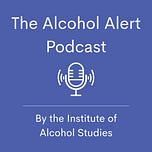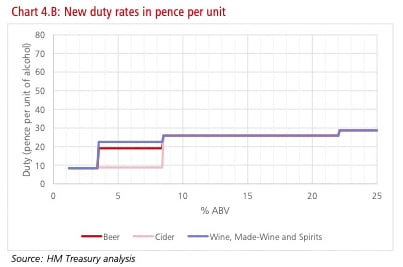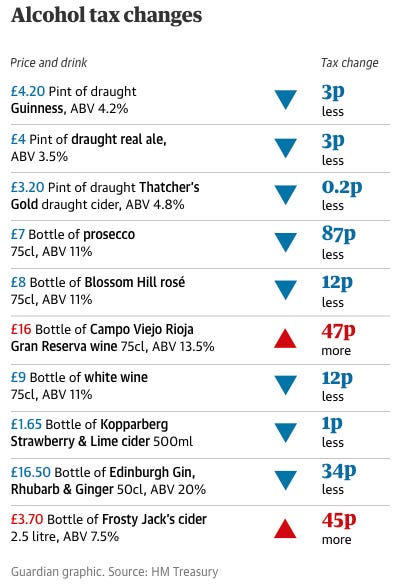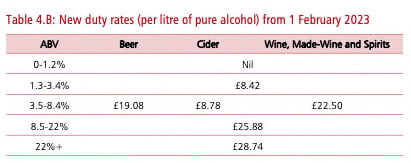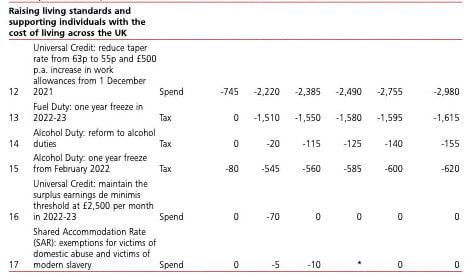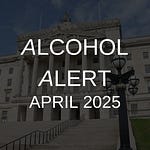Hello and welcome to the Alcohol Alert, brought to you by The Institute of Alcohol Studies.
In this edition:
Upcoming events
This month’s IAS blogs
Big change for alcohol duty but will public health win or lose?🎵 Podcast feature 🎵
Alcohol industry funded websites spread misinformation on cardiovascular risk
How has minimum unit pricing in Scotland affected alcohol-related crime?
The Lords discuss gambling evidence review and links to alcohol harm
Ireland must commence with alcohol labelling or risk further harm
Government rejects call for alcohol to be considered a “less healthy product” and for better labelling of products
Which studies came out?
We hope you enjoy our roundup of stories below: please feel free to share. Thank you.
Upcoming events
Join us on Wednesday 03 November, 14:00-15:30, to discuss alcohol’s impact on the environment, seminar 2 of our four-part sustainability series.
IAS Chief Executive, Dr Katherine Severi, will introduce the seminar and give an overview of the topic, including how the production and distribution of alcohol can affect greenhouse gas emissions, water use and waste, and how climate change may affect alcohol production in future.
Joining us is Dr Modi Mwatsama of the Wellcome Trust, who will go into more detail about how food and drink affects our environment, what individuals can do to reduce their impact, and how we need a food revolution to improve our practices.
Tom Cumberlege of the Carbon Trust will round off the event by discussing the work they do in helping businesses to reduce their environmental impact, including a number of case studies of working with the alcohol industry.
Please register for the event here and come prepared with lots of questions for our panel!
This month’s IAS blogs
Big change for alcohol duty but will public health win or lose?
On 27 October the Chancellor Rishi Sunak unveiled the Government’s Autumn 2021 budget, which saw a big change to alcohol duties: from 2023 alcohol will be taxed based on its strength, so the stronger the alcohol the higher the tax.
However, as many have said, the devil is in the detail.
So what is the detail?
Our current alcohol duty system is full of inconsistencies whereby different drinks are taxed at different rates according to both strength and volume. An overview of the current system is presented in chart 4A, which is taken from the Government’s Alcohol Duty Review consultation document. The new system proposed by the Chancellor will simplify the alcohol duty structures by reducing the number of strength ‘bands’, or Alcohol by Volume (ABV) ranges to apply duty rates to. These bands will be applied more consistently across alcohol product categories and are presented in chart 4B.
The alcohol content bands that duties will now be applied to are: 1.2-3.4% ABV, 3.5-8.4% ABV, 8.5-22% ABV, and above 22% ABV.
For the bands 8.5-22% ABV and above 22% ABV, all products across all categories will pay the same rate of duty. The duty applied to a bottle of rose wine, for instance, will come down by 23p per bottle while strong beer will attract more duty. Here’s an example from The Guardian of how some drinks will change in price.
Draught beer duties will be reduced by 5% for containers over 40 litres, in an attempt to support the hospitality industry. The Campaign for Real Ale (CAMRA) said:
“The introduction of a draught duty rate is a game-changer for cask beer drinkers, cider and perry drinkers and the great British local. This is something CAMRA has campaigned on for many years and we are delighted the Government has listened”.
However the Society for Independent Brewers (SIBA) said it had called for the draught beer duty relief to apply to containers above 20 litres – so that it would benefit craft keg and cask. As the policy only applies to 40 litre containers, bigger companies will benefit more.
One of the less rational aspects of the changes is the continuation of lower duty rates for cider. Under the new proposals, cider will attract less duty than other products of the same strength, until it reaches the higher band of >8.5%. As table 4B below shows, cider duties will be less than half of beer duties for the same strength products.
The Government reasoning for this is that they are “mindful of the significant impact this would likely have on the cider industry. Apple and pear cider clearances have been in decline for the last decade, with volumes decreasing 28% since between 2009 and 2019”.
In response to this, health economist Colin Angus, of the University of Sheffield, said:
“All this does is encourages heavier drinkers to drink cider. Because it's much cheaper. And they do. The Treasury acknowledges the issue, but protests they can't fix the huge disparity, because it would involve there then not being a huge disparity... This is by far the biggest failing of the UK duty system and until somebody fixes it and taxes cider on a par with beer, heavy drinkers are going to continue to do themselves a huge amount of harm drinking incredibly cheap white cider.”
Another announcement at the Budget that sparked concern amongst public health bodies was the freezing of alcohol duties once more this year. As the Treasury’s own figures show below, this will cost the UK Government over £0.5billion every year, as well as increasing harm, which the increase in affordability inevitably leads to.
In response to the changes, IAS Chief Executive Dr Katherine Severi said:
“We welcome the principles outlined in the Chancellor’s alcohol duties review to protect public health and simplify the system by tackling high-strength low-cost alcohol. It is common sense that stronger drinks should cost more, as they do more damage to the health of individuals, to families, and to wider society.
Alcohol harms have been felt more acutely during the pandemic, with alcohol-related deaths increasing 20% in 2020. Unfortunately, today’s freeze on all duties over the next year will do nothing to alleviate these harms in the short-term, which represents a missed opportunity to achieve the public health goals set out by the Chancellor today.
This means the new duty structures will need to work harder to improve public health and tackle inequalities across the UK. We will continue to work with government to push for changes to alcohol duty that result in meaningful health gains and reduce the cost of alcohol to society.”
Professor Sir Ian Gilmore, of the Alcohol Health Alliance, said:
“The decision to once again freeze alcohol duty is totally misguided. We are already at crisis point when it comes to alcohol harm. Deaths caused by alcohol reached record highs in 2020 and making alcohol even cheaper will only deepen the health inequalities that this government had promised to address.”
In terms of next steps, the Government has launched a consultation on the duty changes, the deadline for which is 30 January 2022.
Alcohol industry funded websites spread misinformation on cardiovascular risk
Research by the London School of Hygiene & Tropical Medicine has found that alcohol industry (AI) and AI-funded groups misrepresent the evidence on cardiovascular (CV) effects of moderate alcohol consumption.
The study looked at the accuracy and completeness of CV health information that the alcohol industry and funded groups disseminated, compared to 18 websites of non-AI-funded sources.
The results of the study found:
12 of 18 AI/AI-funded websites refer to CV impacts of drinking, with 9 of those (75%) stating drinking is associated with a reduced risk of at least one CV condition
Ischaemic heart disease was the most frequently mentioned condition
All non-industry groups surveyed referred to CV impacts from alcohol, with alcohol “almost exclusively cited as a risk factor (as opposed to a protective factor) in the development of such conditions
The J-shaped curve theorises that low to moderate alcohol consumption represents optimum exposure to alcohol, with increased risk for non-drinkers and heavy drinkers – see graph below. However, this interpretation has been subject to much criticisim, for instance: moderate drinkers may be better off and have a healthier life in general, abstainers may do so due to various health issues, there are issues with self-reporting, and the curve does not include health externalities such as road deaths or death from partner violence due to alcohol consumption.
The study found that 55% (10 of the 18) of the AI/AI-funded websites mentioned the J-shaped curve, with 5 of those caveating that the association is specific to age groups or using qualifying descriptors such as ‘may have a protective effect’.
In contrast 33% (6 of the 18) of the non-industry groups mentioned the curve, and all who did so discussed associated qualifiers.
The AI/AI-funded websites were much more likely to imply that there is a balance between the positive and negative effects of alcohol on CV risk. Further, the analysis showed that these websites used distraction by focusing on alternative risk factors other than alcohol, such as family history, environment, weight, and poor nutrition – a practice far less common by the non-industry funded groups.
The researchers state that AI/AI-funded groups were more likely to emphasise the set of causes for CVD by discussing potential confounders of the alcohol-CVD relationship. They argue that this is “a common strategy among unhealthy commodity industries, including the tobacco industry, and risks obscuring that alcohol is an independent risk factor”.
They go on to argue that the alcohol industry understands the negative impacts of alcohol on health, but that they frame it as “heart healthy”, and the information they provide does not reflect the best available evidence.
An important point highlighted by the study was that Government-funded sources of information, such as the NHS, “should aim for greater rigour and transparency by using and citing the most up-to-date evidence”. And that NGOs linking to industry-funded websites, such as to Drinkaware, “implies endorsement that is ill-advised given the high risk of bias in health information provided”.
How has minimum unit pricing in Scotland affected alcohol-related crime?
As part of its ongoing analysis of the effectiveness of minimum unit pricing (MUP), Public Health Scotland released a report on 12 October that suggests MUP has had “minimal impact” on alcohol-related crime in the country.
Researchers at Manchester Metropolitan University looked at Police Scotland data from January 2015 to January 2020 to understand the effect MUP had on alcohol-related crime, disorder and public nuisance.
Dr Karl Ferguson, Public Health Intelligence Adviser at Public Health Scotland, said:
“Understanding the impact of MUP on social harms including crime and public safety is an important aspect of the overall evaluation. The findings of this research are in line with previous Public Health Scotland studies which reported limited evidence of increased theft or illicit substance use as a result of MUP. These studies included research into how MUP affected small retailers, people drinking at harmful levels, and children and young people.”
Dr Carly Lightowlers of Liverpool University and Lucy Bryant of IAS looked at the report’s limitations and will publish an IAS blog comprehensively explaining these. The limitations they highlight are:
Further studies will offer additional insights regarding MUP and crime, such as ambulance callouts, hospital admissions and deaths, and MUP and illicit substance use
The Lords discuss gambling evidence review and links to alcohol harm
Following September’s review by Public Health England (PHE) that showed the shocking harm of gambling in England, the Lords debated the issue.
The Lord Bishop of St Albans introduced the debate and said that the gambling industry must pay more to reduce the harm it causes. He highlighted the pressure the industry puts on people to continue to gamble, pushing people toward huge debts and sadly some towards suicide. He argued that the Government must approach it from a public health perspective to prevent further harm.
Lord Foster of Bath agreed with the Lord Bishop and added there is a wide range of gambling-related harms, including alcohol dependency. He argued that gambling harm should be tackled in a similar way to drug and alcohol harm – by giving it a higher profile, better resourcing, and a public health approach.
Baroness Bennett of Manor Castle raised the issue of gambling and alcohol advertising, saying that we are “trailing on the global scale of controls on this out-of-control industry”. She highlighted how Sweden is “proposing restrictions on gambling parallel to its tight restrictions on alcohol advertising” and that Portugal “has just brought in a ban on advertising on TV and radio between 7 am and 10.30 pm”.
Baroness Bennett went on to say:
“It is interesting that so many nations are tying together alcohol and gambling advertising, because this review demonstrates that alcohol consumption is strongly associated with gambling. The noble Lord, Lord Robathan, talked about leaving it to individual responsibility, but that is obviously a problem when you combine gambling opportunities with alcohol.”
Ireland must commence with alcohol labelling or risk further harm
In a letter to the Irish Journal of Medical Science, Dr Nathan Critchlow et al, argued that Section 12 of Ireland’s Public Health (Alcohol) Act 2018 should commence as soon as possible.
Section 12 stipulates a number of mandatory packaging requirements for alcohol:
Critchlow stated that as there is no scheduled commencement date for Section 12 it prolongs the reliance on the self-regulatory presentation of this health information to the public. He also argued that the initial COVID-19 lockdowns, due to increasing home drinking, would have provided maximum exposure to such health warnings, but that sadly this has been missed.
Highlighting the reason why Section 12 needs implementing as soon as possible, Critchlow wrote that it is supported by the public, there is proof that it works in reducing harm, and that tobacco warning labels already provide a template on how best to design such labels.
Discussing the tobacco industry and their use of litigation to attempt to prevent or slow public health changes, Critchlow warned that the alcohol industry is likely to use litigation too. However he said that the tobacco industry is “seldom successful”, inferring that the same may be true for alcohol industry attempts.
Critchlow et al rounded off their letter by stating that:
“Strong political leadership was key to the passage of the Act and will likely be needed to advance Sect. 12 if this policy is to fulfil its intended purpose.”
Government rejects call for alcohol to be considered a “less healthy product” and for better labelling of products
A less healthy product
The Commons debated the Health and Care Bill on 26 October, including amendments to include alcohol as a “less healthy” product and therefore liable to the watershed ban on unhealthy product ads and online ad ban of such products.
Labour MP Alex Norris argued that:
“One of the few parts of the obesity strategy where we have departed from the Government’s view is the curious decision to remove alcohol, particularly with regard to calories and labels. We all know that alcohol is a less healthy product—I may well be the billboard for that, certainly when it comes to weight—so why has it been left out? Our amendments are more probing than an attempt to actually change the Bill, because I hope that alcohol has already been covered. However, in the obesity strategy in general, it seems to have disappeared, which seems very odd. I hope that the Minister can explain his thinking on that.”
In response to Mr Norris’ argument, Conservative Minister for Health, Edward Argar, argued that the Government is committed to ensuring children are protected from alcohol marketing via rules in advertising codes.
After listing out some of those codes – for instance that no more than 25% of audience can be children and ads must not strongly appeal to children – Argar said:
“We do not believe it is necessary to consider alcohol a less healthy product in this context, or to apply the new restrictions to it”, going on to say that less healthy food and drink are unique and different to alcohol as they are not age-restricted when purchasing.
Argar said that as the consultations on advertising restrictions didn’t include alcohol, we can’t be sure of the impact of the amendments on the advertising industry, regulator, alcohol industry or “wider public opinion”.
He concluded that:
“Material in the broadcast code and non-broadcast code relating to the advertising and marketing of alcohol products is already robust. That recognises the social imperative to ensure that alcohol advertising is responsible and, in particular, that children and young people are suitably protected. If new evidence emerges that clearly highlights major problems with the existing codes, the Advertising Standards Authority has a duty to revisit them and take appropriate action. For those reasons, I encourage the hon. Member for Nottingham North not to press the amendments to a vote.”
As a recent report co-funded by IAS, AAI and SHAAP highlighted, the current self-regulatory alcohol advertising policy is anything but robust when it comes to preventing children from exposure to alcohol ads, particularly during sporting events. It showed ‘responsible drinking’ messages were only visible in 0.4% of the alcohol references during the 2020 Six Nations England vs. Scotland match. If 25% of the 120 million Six Nations audience were children, it would be acceptable, under the self-regulatory rules, for 30 million children to see this advertising.
Better labelling
On 28 October the Commons debated an alcohol product labelling clause, that would ensure alcoholic drinks display:
Labour MP Alex Norris argued that people have the right to know what they’re consuming and the risks, highlighting research that shows 80% of people don’t know the calories in a large glass of wine.
He went on to say that not enough people know of the dangers of drinking while pregnant, particularly around the issue of FASD and the profound impact that it has on a child’s development. Norris also highlighted a recent YouGov report that shows the public are in favour of more information on alcoholic products.
Norris asked the Secretary of State to introduce secondary legislation to include this information, which he said is a “modest ask, but it promotes informed choice”.
In response Conservative Edward Argar agreed that people have the right to accurate information but that the clause is unnecessary as the Government is about to launch a consultation on labelling and all stakeholders must be involved. He said if the decision is taken to mandate labelling requirements, the Government will do so through a new power in the Food Safety Act 1990.
Norris said he respected the process although highlighted that the consultation shouldn’t be confused with action, and that there is a growing sense of impatience
Additional studies published this month
The UK Alcohol Alert (incorporating Alliance News) is designed and produced by The Institute of Alcohol Studies. Please click the image below to visit our website and find out more about us and what we do, or the ‘Contact us’ button. Thank you.



